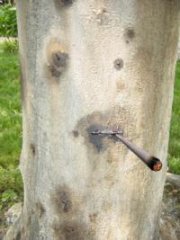-
Posts
31 -
Joined
-
Last visited
Quercus Robert's Achievements
Apprentice (3/14)
Recent Badges
-

Bacterial Infection of Olive Trees in Southern Italy
Quercus Robert replied to ths907's topic in Tree health care
Isn't this issue strikingly similar to the plight of ash trees? I.e., weakened trees succumbing to a pathogen.- 13 replies
-
- italy
- olive trees
-
(and 1 more)
Tagged with:
-
I've seen SOME squirrels. But certainly, in the forest of Bere, just for example, this same bark damage is all around (on sweet chestnut), and I've seen seen no squirrels. I'm not saying there isn't an army of squirrels out there; I did not realise they were so destructive. Jim, I did pretty much assume the warm weather was responsible for immature figs ripening. Oh! That reminds me: Investigating the warm weather - the unseasonably HOT weather, I should say - I came across the Arctic Methane Emergency Group. Arctic Methane Emergency Group - AMEG - Arctic Sea Ice - Methane Release - Planetary Emergency These scientists are VERY worried about the release of methane hydrates from thawing Siberian permafrost. There's an estimated 10,000 gigatons there, 60 of which are enough to propel the planet into a Permian-style mass extinction. They also estimate a complete summer icecap melt either about now or next September. So that's quite exciting.
-
Do the leaves seem as though they've been scorched?
-
-
Looks like it may even have spines on the bottom rather than pores.
-
OK well spontaneous xylem cavitation is interesting. Has the weather changed enough to cause this? Presumably this would be dramatic swings in weather conditions causing sap pressure in the xylem to drop below that of dissolved air. Well, investigating this avenue looks horrendous. Re your comments on Milgram, I totally agree that people are, or would be, unable to change their behaviour even if (when) faced with the undeniable proof that their actions are devastating their environment. Look at Fukushima: they haven't succeeding in capping it. All the US environmental agencies did was raise their postulated "safe" level of radiation by about 10,000% - then carry on greenlighting more nuclear plants. I don't think people are stupid - I think a very quick calculation occurs when these issues arise, balancing long-term hardship against short-term gain, and short-term gain wins, every time, because that's how we're wired. Re levels of aluminium, I thought aluminium was reasonably plentiful within the environment. How can aluminium be in air? I am aware that it is a common link in certain human metabolic diseases (I include autism here), though every disease is of course unique and multifactorial. pH change - OK well there were efforts to establish soil monitoring schemes in the UK circa 2008... Defra, UK - Science Search ...under the auspices of the Environment Agency. Here: http://www.sniffer.org.uk/files/8313/4183/8007/LQ09_Project_Summary.pdf the same thing is mentioned ("Next Steps This project feeds into the next phase of the UK-SIC remit, which involves the designing of a UK Soil Monitoring Scheme.") (2007) Finally I find a soil map, which is pretty interesting: United Kingdom Soil Observatory But crowdsourced? The pH measurements appear meaningless.
-
I don't know anything whatsoever about pittosporaceae, I'm afraid, I just thought I'd look them up and found the same disease symptoms. The other tree was far worse, to be fair.


































